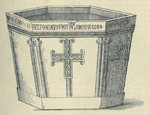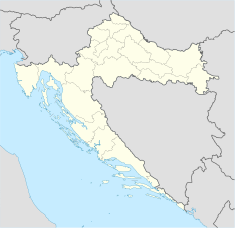Zagreb Cathedral
| Zagreb Cathedral | |
|---|---|
| Cathedral of the Assumption of Mary | |
Croatian: Katedrala Uznesenja Blažene Djevice Marije i svetih Stjepana i Ladislava | |
 Zagreb Cathedral before the 2020 earthquake | |
| 45°48′52″N 15°58′47″E / 45.81444°N 15.97972°E | |
| Location | Zagreb |
| Country | Croatia |
| Denomination | Roman Catholic |
| History | |
| Status | Cathedral |
| Relics held | Sarcophagus of Blessed Aloysius Stepinac, Croatian martyrs Petar Zrinski and Fran Krsto Frankopan, whose bones were transferred from Wiener Neu Stadt in 1919 A.D., Ivan Antun Zrinski, Eugen Kvaternik etc |
| Architecture | |
| Functional status | Under reconstruction |
| Heritage designation | Register of Cultural Goods of Croatia |
| Designated | 2013 |
| Architect(s) | Hermann Bollé (last reconstruction) |
| Style | Gothic (original) Gothic Revival (19th century reconstructions) |
| Years built | Mid-13th century 1880–1906 (reconstruction/additions) |
| Specifications | |
| Number of spires | 2 |
| Spire height | 108 m (354 ft) |
| Bells | 5 (North Tower) 3 (South Tower)[1] |
| Administration | |
| Archdiocese | Zagreb |
| Clergy | |
| Archbishop | Dražen Kutleša |
| Native name Croatian: Zagrebačka katedrala | |
| Location | Zagreb, Croatia |
| Architect | Hermann Bollé (last reconstruction) |
| Governing body | Zagrebačka katedrala |
| Type | Movable cultural good |
| Designated | March 9, 2013[2] |
| Reference no. | P-3621 |
| Protected assets | Plenarium and crucifix from the cathedral treasury |
| Part of a series on the |
| Catholic Church in Croatia |
|---|
 |
Zagreb Cathedral (Cathedral of the Assumption of the Blessed Virgin Mary and Saints Stephen and Ladislav), is a Roman Catholic cathedral located at Kaptol, Zagreb. It is the second tallest building in Croatia and also the most monumental sacral building of Gothic architecture southeast of the Alps.[3] It is one of the most important and biggest symbols of the city of Zagreb and Croatia, and in 2013 it entered in the Register of Cultural Goods of Croatia. It is dedicated to the Assumption of Mary and to kings Saint Stephen and Saint Ladislaus. The cathedral is typically Gothic, as is its sacristy, which is of great architectural value. Its prominent spires are considered to be landmarks as they are visible from most parts of the city. The cathedral is 108.4 meters high, making it one of the tallest churches in the world. Due to 2020 Zagreb earthquake one of its two spires was damaged, so cathedral is under reconstruction until further.
History[edit]
In 1093 when King Ladislaus I of Hungary (1040-1095) moved the bishop's chair from Sisak to Zagreb, he proclaimed the existing church as a cathedral. Construction on the cathedral started shortly after his death and was finished in 1217 and consecrated by king Andrew II of Hungary. The building was destroyed by the Mongols in 1242 but rebuilt by bishop Timothy (1263–1287) a few years later. At the end of the 15th century, the Ottoman Empire invaded Croatia, triggering the construction of fortification walls around the cathedral, some of which are still intact. In the 17th century, a single fortified renaissance watchtower was erected on the south side and was used as a military observation point, because of the Ottoman threat.
The cathedral was severely damaged in the 1880 Zagreb earthquake. The main nave collapsed and the individual tower was damaged beyond repair. The restoration-reconstruction of the cathedral in Neo-Gothic style was led by Hermann Bollé, bringing the cathedral to its present form. As part of that restoration, two spires 104 m (341 ft) high were raised on the western side, both of which are now[when?] in the process of being restored as part of an extensive general restoration of the cathedral.[4]
The cathedral was depicted on the reverse of the Croatian 1000 kuna banknote issued in 1993.[5]
Renovations on the cathedral's towers began in 1990, and have not been completely free of scaffolding for over three decades.[6]
When facing the portal, the building is 46 meters wide and 104 and 105 meters high, respectively.[7] The cathedral contains a relief of Cardinal Aloysius Stepinac with Christ done by the Croatian sculptor Ivan Meštrović.
Popes in Cathedral[edit]
In 1994, Pope John Paul II visited Zagreb Cathedral. During his first visit to the Republic of Croatia on the 900th anniversary of the founding of the Zagreb Diocese. "Today I am here, in Croatian land, as a bare-handed pilgrim of the Gospel of Christ, which is a message of love, harmony and peace" said Pope John Paul II, who in the 1990s was one of the key figures for Croatia's international recognition. During his visit to the cathedral, he prayed at the grave of Cardinal Alojzije Stepinac, whom he said was "the brightest figure and true man of the Church" and in 1998 he declared him blessed of the Catholic Church.[8]
The cathedral was also visited by Pope Benedict XVI on 5 June 2011 where he celebrated Sunday Vespers and prayed before the tomb of Blessed Aloysius Stepinac.
21. century[edit]
The cathedral was damaged in the 2020 earthquake on 22 March, in which the tip of its southern spire broke off and crashed onto the roof of the adjacent Archbishop's Palace.[9] On 17 April 2020, the northern spire of Zagreb Cathedral was removed due to leaning during the earthquake.[10][11][12]
In May 2024, the cathedral was seen without 30 meters of both North and South spires. The Croatian construction company "Spegra" explained that they are currently in process of replacing each stone block (each of them weights 100 kilos, some of them up to 1200 kilos), then they are 3D printed, and replaced with new travertine blocks. For a long time, the Zagreb Cathedral was left without most of its towers, almost like the Notre Dame Cathedral in Paris, and recently it is about 30 meters shorter, because as part of the extensive reconstruction due to the earthquake, all damaged pieces were removed. The bell tower blocks that were damaged and were removed can be seen lined up in front of the cathedral, each marked with its own bar code. As of 2024 the cathedral is still under mayor renovation, and the exact date of re-opening is still unknown.[13]
Treasury[edit]
The cathedral holds a treasury (riznica) that include various metal vessels, liturgical vestments, and liturgical books collected during various periods of its history. Among these objects most notable are:
- medieval St. Ladislaus cloak[14]
- Plenarium made out of ivory[14]
- baroque Reliquary-bust of King Saint Stephen[14]
- a Betlehem child mummy apparently killed by the order of king Herod and brought to Zagreb by king Andrew II[14][15]
- an apparent piece of a true cross[14]
- a piece of king Ladislaus' arm[14]
Gallery[edit]
-
1880 pre-earthquake Cathedral and its tower's view from Jelačić Square with old square spire
-
Cathedral under construction (ca. 1890s)
-
Post 1900 view with fortifications intact
-
Facade
-
Mary column in front of the Cathedral
-
Entrance portal
-
Eastern view
-
Cathedral during 1980s
-
Areal view of the Cathedral
-
Nave, altar and pulpit
-
Gargoyle on Zagreb Cathedral
-
Cathedral in view behind the Church of Saint Mary
-
Neo-Gothic tower on Zagreb Cathedral
-
Lateral interior
-
Stained glass
-
Interior nave
-
Coffin
-
Altar
-
Holy mass
See also[edit]
- History of Zagreb
- History of Croatia
- St. Mark's Church
- Kaptol
- Gradec
- Ban Jelačić Square
- List of Gothic Cathedrals in Europe
References[edit]
- ^ "Zvona zagrebačke katedrale" [Bells of the Zagreb Cathedral]. Glas Koncila (in Croatian). Archived from the original on August 17, 2011.
- ^ Register of Cultural Goods of Croatia. "Izvod iz registra kulturnih dobara Republike Hrvatske br. 01/10 - Lista preventivno zaštićenih dobara" [Excerpt from the register of cultural goods of the Republic of Croatia No. 01/10, List of preventively protected goods]. Narodne novine (in Croatian). Ministry of Culture (Croatia).
- ^ Gavrilović, Feđa (January 12, 2012). "Razbijene zastarjele predrasude" [Obsolete prejudices shattered]. Vijenac (in Croatian). No. 466. Matica hrvatska. ISSN 1330-2787. Retrieved April 7, 2018.
- ^ Archdiocese of Zagreb - Archdiocese of Zagreb - History of the Cathedral
- ^ Croatian National Bank. Features of Kuna Banknotes Archived 2009-05-06 at the Wayback Machine: 1000 kuna Archived 2009-05-11 at the Wayback Machine. – Retrieved on 30 March 2009.
- ^ Rowlands, Marc (April 22, 2020). "Save your tears for the cathedral, its promise is a greater symbol of Zagreb than its towers". Time Out.
- ^ Zagreb, Vladimir from Visit (March 20, 2018). "Zagreb Cathedral of the Assumption of the Blessed Virgin Mary » Visit Zagreb". Visit Zagreb. Retrieved October 9, 2022.
- ^ "Pape u Katedrali". Zagrebačka katedrala. Retrieved April 14, 2024.
- ^ "Sa zvonika katedrale pao križ i jako oštetio Nadbiskupski dvor kardinala Bozanića" [A cross fell from the bell tower of the cathedral and badly damaged the Archbishop's Palace of Cardinal Bozanić]. Večernji list (in Croatian). March 22, 2020. Retrieved March 22, 2020.
- ^ "Vrh sjevernog tornja zagrebačke katedrale uspješno uklonjen i spušten na tlo" [The top of the north tower of the Zagreb Cathedral was successfully removed and lowered to the ground]. dnevnik.hr (in Croatian). Retrieved April 18, 2020.
- ^ "Eksplozijama odvojen toranj katedrale, prizemljen je" [The tower of the cathedral was separated by the explosions, and grounded]. index.hr (in Croatian). April 17, 2020. Retrieved April 18, 2020.
- ^ "Rušenje tornja zagrebačke katedrale" [Demolition of the Zagreb Cathedral tower]. hr.n1info.com (in Croatian). April 17, 2020. Archived from the original on May 1, 2020. Retrieved April 18, 2020.
- ^ Sutlić, Korana. "Skoro nitko nije primijetio da je zagrebačka katedrala skraćena za 30 metara: 'To nije bio plan'". Jutarnji List. Retrieved May 23, 2024.
- ^ a b c d e f "Sve tajne crkvenog blaga: Skrivali ga od ratova, lukavih kradljivaca, a njegova je vrijednost - neprocjenjiva" [All the secrets of the church treasure: They hid it from wars, cunning thieves, and its value is priceless]. tportal.hr (in Croatian). Retrieved July 27, 2023.
- ^ "Relikvije, kosti, krv, ljubavna pisma: RTL Direkt otkriva zanimljivosti riznice zagrebačke katedrale!" [Relics, bones, blood, love letters: RTL Direkt reveals the interesting things of the treasury of the Zagreb Cathedral!]. danas.hr (in Croatian). June 23, 2016. Retrieved July 27, 2023.
External links[edit]
- Zagreb Cathedral; Zagreb Tourist Info
- Zagreb Cathedral; Visit Zagreb - Travel Guide
- Zagreb Cathedral
- "Đavlova glava u zagrebačkoj katedrali" (in Croatian)
- Zagreb cathedral in the 1880 earthquake and its present day renovation (in Croatian)
- Roman Catholic churches completed in 1906
- 1906 establishments in Croatia
- Religious buildings and structures in Zagreb
- Tourist attractions in Zagreb
- Gornji Grad–Medveščak
- Hermann Bollé buildings
- Roman Catholic cathedrals in Croatia
- 13th-century Roman Catholic church buildings in Croatia
- Gothic architecture in Croatia























